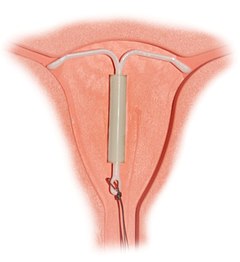IUD with progestogen
| IUD with progestogen | |
|---|---|

Correctly inserted IUD
|
|
| Background | |
| Type | Intrauterine |
| First use |
1990 (Mirena—currently available) |
| Synonyms | intrauterine system (IUS), levonorgestrel intrauterine system |
| Trade names | Kyleena, Liletta, Mirena, Skyla, others |
| AHFS/Drugs.com | Multum Consumer Information |
| Failure rates (first year) | |
| Perfect use | 0.2% |
| Typical use | 0.2% |
| Usage | |
| Duration effect | 5-7 years (Mirena), 3 years (Skyla) |
| Reversibility | 2–6 months |
| User reminders | Check thread position monthly |
| Advantages and disadvantages | |
| STI protection | No |
| Periods | Menstrual irregularity, periods usually lighter or none at all |
| Weight | Potential side effect |
| Benefits | No need to remember to take daily action |
| Risks | benign ovarian cysts, transient risk of PID, uterine perforation (rare) |
1990 (Mirena—currently available)
Intrauterine device (IUD) with progestogen, sold under the brand name Mirena among others, is a intrauterine device that releases the hormone levonorgestrel. It is used for birth control, heavy menstrual periods, and to prevent excessive build of the lining of the uterus in those on estrogen replacement therapy. It is one of the most effective forms of birth control with a one-year failure rate around 0.2%. The device is placed in the uterus and lasts three to five years. Following removal fertility returns quickly.
Side effects include irregular periods, benign ovarian cysts, pelvic pain, and depression. Rarely uterine perforation may occur. Use is not recommended during pregnancy but is safe with breastfeeding. The IUD with progestogen is a type of long-acting reversible birth control. It works by making the mucous at the opening to the cervix thick, stopping the buildup of the lining of the uterus, and occasionally preventing ovulation.
The IUD with levonorgestrel was first approved for medical use in 1990 in Finland and in the United States in 2000. It is on the World Health Organization's List of Essential Medicines, the most effective and safe medicines needed in a health system. The wholesale cost in the developing world is about US$122.46 each. In the United Kingdom they cost the NHS about £88 pounds. In the United States they cost around US$844.00. More than 120 countries have approved the device and it is used by more than 10 million women.
...
Wikipedia
